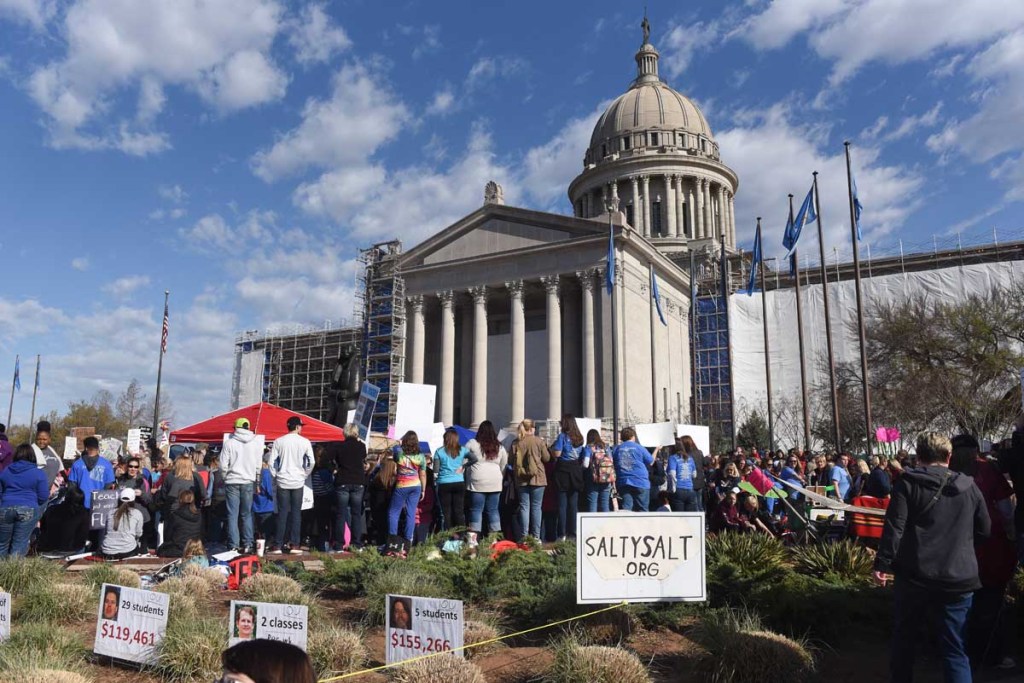Oklahoma officials: Walkout costing an additional $115,000 per day
Published 4:56 pm Monday, April 9, 2018

- Oklahoma teachers rally at the Capitol, Monday, April 9, 2018, during day six of the Oklahoma teacher walkout. (
OKLAHOMA CITY — As the sixth day of the Oklahoma educator walkout dawned with no end in sight, Oklahoma officials said the movement is costing taxpayers at least $115,000 day.
That price tag includes the $100,000 a day for Department of Public Safety personnel. Additionally, an estimated cost of $15,000 a day funds extra personnel working inside the Oklahoma Capitol tasked with janitorial services, trash pickup, and repairing damage to the grounds due to all the additional foot traffic, said Shelley Zumwalt, with the Office of Management and Enterprise Services.
Meanwhile, the crowds Monday appeared to reach their largest levels yet as the second week of the teacher walkout got underway.
Many of Oklahoma’s largest districts remain closed in an effort to allow teachers to advocate at the Capitol. Buses drove up and down Lincoln Boulevard, dropping off contingents of educators from across the state.
As the overcast skies cleared and colder temperatures that plagued attendees for much of the first week warmed up, the weather became more seasonable in Oklahoma City.
The area just outside the Capitol took on a festival-like atmosphere. Brightly colored tents sprang up across the front lawn like mushrooms. Vendors hawked their wares while signature gatherers worked in an effort to get measures on the November ballot. Food trucks converged on the area, and teachers waited in long lines for lunch.
Inside, educators continued to press lawmakers to increase funding to K-12 schools.
The state’s largest teacher’s union, the Oklahoma Education Association, said Friday that teachers won’t return to their classrooms until Republican Gov. Mary Fallin vetoes a legislative measure repealing a $5 per night hotel/motel tax that was supposed to help fund the recent permanent, average $6,100 teacher raises. Educators are also demanding that lawmakers pass a measure ending the state’s capital gains tax exemption, which could add $120 million to the state’s budget annually.
As average crowd sizes easily topped 25,000 for most of the first week, Department of Public Safety Commissioner Rusty Rhoades said the agency has had to deploy more than 100 troopers to the Oklahoma Capitol to bolster existing security.
“We literally have guys from every corner of the state (at the Capitol),” he said. “And those areas up there are going to start to suffer a little bit because we can’t provide the same service.”
In the first week of the walkout alone, the agency spent nearly $500,000. Rhoades said those costs include trooper salaries, fuel, overnight accommodations for troopers who have had to be brought in from outlying parts of the state, a command post and other expenses.
The Oklahoma agency is dipping into funds that are typically set aside to pay for disaster response during storm season to pay walkout expenses, Rhoades said.
If the emergency funds are exhausted, Rhoades said the agency will likely have to make cuts to balance their budget, like not hiring civilians to fill vacancies and not buying new police units.
That price tag also does not include the cost of port-a-potties that line the Capitol parking lot or the charter buses shuttling thousands of teachers to and from the Capitol each day.
Doug Folks, a spokesman for the teacher’s union, said his group is footing those expenses, but did not know what those were costing.
And as the walkout continued, Oklahoma Superintendent Joy Hofmeister announced the state plans to extend its standardized testing schedule by a week. Testing was supposed to start April 2.
Federal law requires every district administer a variety of academic tests to students. If Oklahoma fails to conduct the required assessments, the U.S. secretary of education could withhold federal education funding, officials said.
About 15 percent — or $820.7 million — of Oklahoma’s current K-12 funding comes from the federal government.
Students also must pass some of the tests to advance to the next grade or graduate from high school.
“Our schoolchildren must have the opportunity to confidently show their best work,” Hofmeister said in a statement. “This extension is essential to better support students and ensure an appropriate transition back into classrooms.”
Stecklein covers the Oklahoma Statehouse for CNHI’s newspapers and websites. Reach her at jstecklein@cnhi.com.



